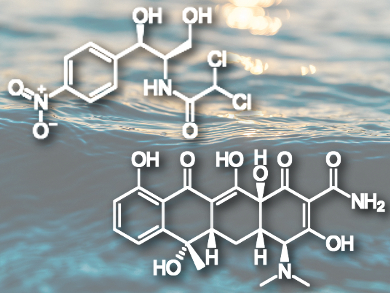Antibiotic residues in water can contribute to the development of resistant bacteria. Adsorption is a simple and promising method for the removal of antibiotics, especially with magnetic materials that are easy to separate and recycle. However, many magnetic adsorbents have relatively small specific surface areas and adsorption capacities.
Baoliang Zhang, Qiuyu Zhang, and colleagues, Northwestern Polytechnical University, Xi’an, China, have developed a magnetic hyper-crosslinked polymer with a large specific surface area for the removal of antibiotics from water. The team crosslinked ferrocene with dimethoxymethane using a Friedel-Crafts reaction with AlCl3 as the catalyst. This results in a hyper-crosslinked polymer, which was oxidized using hydrogen peroxide to create Fe3O4 within the polymer network and make the material magnetic.
The team tested the material’s suitability for antibiotic absorption from water using chloramphenicol (pictured top) and tetracycline hydrochloride (pictured bottom). They found high maximum adsorption capacities of 114.94 and 212.77 mg/g, respectively, at 20 °C. The adsorbent could be recovered and reused with only small losses in adsorption efficiency.
- Preparation of Magnetic Hyper-Cross-Linked Polymers for the Efficient Removal of Antibiotics from Water,
Yin Liu, Xinlong Fan, Xiangkun Jia, Xin Chen, Aibo Zhang, Baoliang Zhang, Qiuyu Zhang,
ACS Sustainable Chem. Eng. 2017.
DOI: 10.1021/acssuschemeng.7b02252




